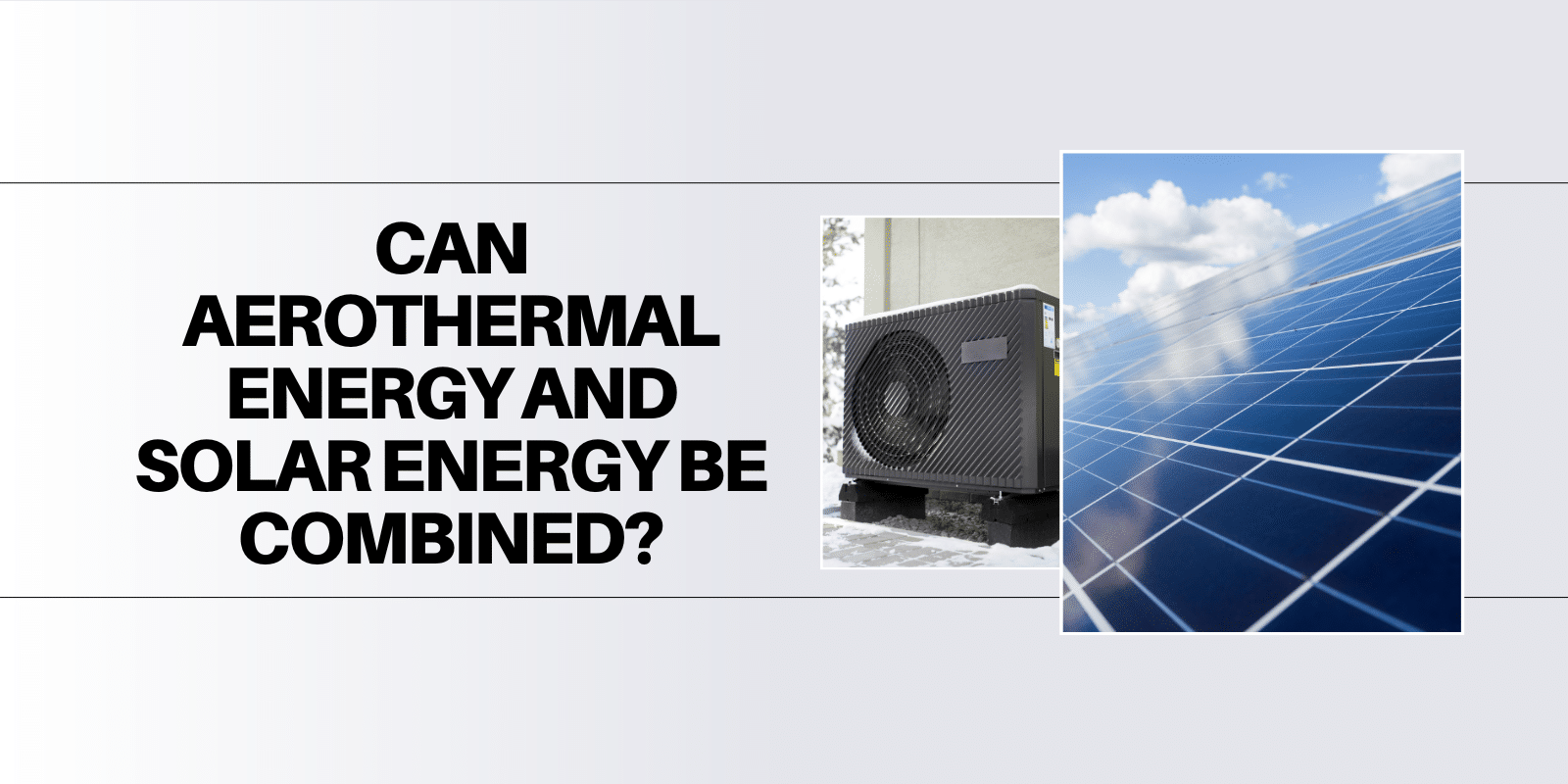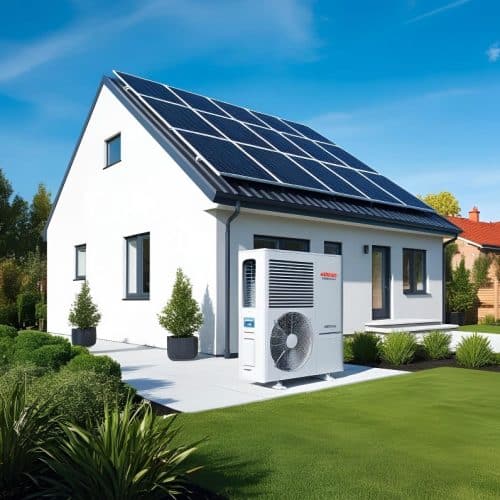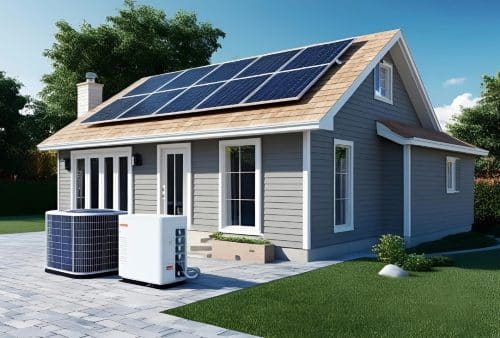
14 May Can Aerothermal Energy and Solar Energy Be Combined?
The answer to this question is yes, and it’s highly recommended because aerothermal energy and solar energy stand out for their ability to harness renewable natural resources, and combining aerothermal energy and solar energy is one of the most advanced and sustainable solutions for air conditioning and hot water production in homes and buildings. Although both technologies differ in their operation, they complement each other perfectly to maximize energy efficiency, reduce electricity bills, and minimize environmental impact.
What is Aerotermia?

What is Solar Energy?
Solar energy is a form of renewable energy obtained from the electromagnetic radiation emitted by the Sun, mainly in the form of light, heat, and ultraviolet rays. This energy reaches Earth and can be harnessed through different technologies to generate electricity or heat useful for various purposes. There are two main ways to harness this source: solar thermal energy , which uses solar panels to heat water, and solar photovoltaic energy , which converts sunlight into electricity using photovoltaic cells. Solar energy is one of the cleanest and most abundant forms of electricity generation and can be installed in both homes and large commercial facilities.
How Can Aerothermal Energy and Solar Energy Be Combined?
The combination of aerothermal energy and solar energy has the potential to maximize the efficiency of air conditioning and domestic hot water (DHW) systems. Below are some of the ways these two technologies can be integrated:
1. Optimization of the Aerothermal System with Photovoltaic Solar Energy
One of the most common integration methods is to use photovoltaic solar panels to power air source heat pumps. Air source heat pumps require electricity to operate. Solar energy, through photovoltaic panels, generates electricity that can power the air source heat pump, thereby reducing electricity consumption and dependence on the conventional grid, reducing grid energy consumption, and therefore, lowering electricity bills.
2. Integration with Solar Thermal Energy for Domestic Hot Water
Solar thermal energy can be used to supplement domestic hot water (DHW) production from an air source heat pump. In this case, the solar thermal panels heat the water, reducing the workload of the heat pump.
3. Combination of Aerothermal and Solar Energy in Air Conditioning and Refrigeration
In addition to heating water, aerothermal energy can also be used for air conditioning through cooling systems. Here, photovoltaic solar panels can power the aerothermal system to cool the space, especially during the warmer months.

Benefits of Combining Aerothermal Energy and Solar Energy
- Improved Energy Efficiency : Maximizes the use of renewable energy and reduces grid energy consumption. Combining both technologies can reduce energy consumption and make the system more efficient, as both technologies harness renewable natural resources: air and sunlight.
- Economic savings: Combining aerothermal energy and solar energy significantly reduces electricity bills, as much of the energy needed for air conditioning and hot water comes from the sun. Furthermore, the aerothermal system, running on renewable electricity, is much more economical in the long run than conventional heating and cooling systems.
- Emissions reduction: Both technologies are environmentally friendly. By reducing their dependence on fossil fuels and leveraging clean energy, they reduce their carbon footprint and CO₂ emissions.
- Energy Autonomy : In some cases, it is possible to achieve a certain energy autonomy, especially in isolated homes or in regions with good solar radiation, which reduces the need to connect to the electricity grid.
- Compatibility and Adaptability : Both technologies are modular and scalable. This means the systems can be adapted to the energy needs of different types of homes or buildings, from single-family homes to large commercial complexes.
Disadvantages of combining Aerotermia and Solar Energy
While the combination of aerothermal and solar energy offers many benefits, there are also certain challenges that must be considered:
- Initial investment : Combining geothermal energy and solar energy involves a considerably higher initial cost than conventional systems. This outlay can be a barrier for some users, although the investment is usually recovered in the medium to long term.
- Space Requirement : Both systems require space both indoors (for the heat pump and equipment) and outdoors (for the solar panels and the outdoor heat pump unit). This can be a problem in homes with limited space, especially in urban settings.
- Climate conditions : Although both systems can operate in a wide range of climate conditions, their efficiency will depend on solar radiation and outside air temperature. Solar energy efficiency depends on available solar radiation, so energy production decreases on cloudy or dimly lit days. Furthermore, aerothermal energy efficiency also decreases in very cold climates, which may require backup systems to ensure comfort.
- Medium/long-term payback: Although the energy savings are significant, the return on investment is not immediate and may require several years to achieve the expected profitability.
- Need for a prior technical study: To maximize efficiency and savings, proper system sizing and design are essential. Poor planning can negatively affect overall performance. The important thing is to have a team of professionals who can conduct an analysis of your situation and provide you with the most appropriate solutions. At Soma Genpower, we have the experience and qualified professionals to advise you on how to combine aerothermal energy and solar energy to maximize the benefits of your installation.
Conclusion
Combining aerothermal energy and solar energy is a highly efficient and sustainable solution for reducing energy consumption, optimizing indoor comfort, and cutting carbon emissions. This integration maximizes efficiency, reduces costs, and minimizes environmental impact, making it one of the best options for air conditioning and hot water production in homes or businesses.
The key is that aerothermal energy, although very efficient, requires electricity to operate. If that electricity comes from solar panels, the system becomes much more sustainable and cost-effective. Furthermore, excess solar energy can be stored (for example, in batteries or in the form of hot water) for use when the sun is not shining, further optimizing energy consumption.
More and more homes and commercial buildings are choosing to combine geothermal and solar energy, and the development of complementary technologies (such as battery storage) is making these solutions even more accessible and efficient.
If you’re looking for a way to make your home or business more sustainable by combining geothermal energy and solar power, contact us and we’ll advise you on your specific needs without obligation.
At Soma Genpower, we are experts in the installation of photovoltaic and aerothermal systems, and in the combination of both. We invite you to visit our installations section where you can see some of our work.
We also invite you to visit our online store for electrical components.


No Comments